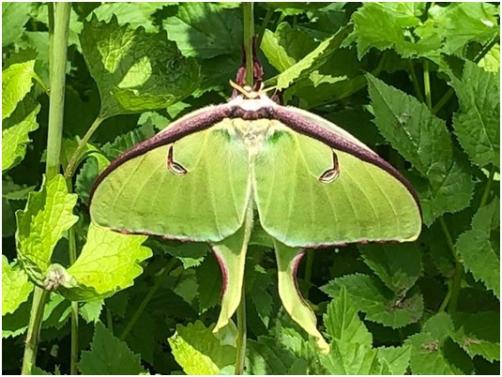
4 minute read
Willows Park Preserve

BY MARY COELUNA
Advertisement
It only comes out at night. And it spends its entire adulthood high in the treetops. So I had come to accept the sorry truth that this was something I would never see - like the view from the summit of K2 or the bottom of my laundry basket. But there it was, clinging to a tall blade of grass, immobile, either oblivious or indifferent to the seven hikers hovering above it, bending closer, iPhone cameras clicking against a chorus of “oooohs” and “aaaaahs.”
“What is it?” asked one of the hikers. A fantasy creature, a mythical beast, something out of a fairy tale, far too beautiful - eerily beautiful - to be real.
And yet. Here we are at The Willows Park in Radnor, on a Saturday afternoon in the spring, staring at it with childlike curiosity and awe.
“It's a Luna moth,” I said.
All this fuss over a moth? Let me explain. The Luna moth is no ordinary moth. You won't find it munching on that cashmere sweater in your closet. You won't find it lurking in your pantry, behind the bag of flour which was “best used by” Y2K. You won't find it hanging out with a bad crowd at your lamp post or porch light after dark. This is a very special moth, from a good family (Saterniidae) that includes emperor moths, royal moths and giant silk moths. It's the only moth to have appeared on a U.S. postage stamp (June 1987). It was once used in an advertisement for the insomnia medicine Lunesta.
The Luna moth is one of the largest moths in North America and arguably the most beautiful. Its wingspan can exceed seven inches. Those wings are a pale, ghostly shade of green, the males leaning towards yellow, the females toward blue. Both its forewings and hindwings feature a single “eyespot” with arcs of black, blue, green, yellow, red or white. These vivid eyespots are intended to confuse predators. The forward edges of the forewings are thick and brown or maroon in color, tapering from the head to the wing tip. The hind wings have long, sometimes twisted tails believed to interfere with echolocation detection by predator bats. Its antennae are feathery, the males having larger antennae than the females. The body is white and hairy. With its wings fully extended, the Luna moth resembles a ballerina en pointe with arms extended and draped in a gossamer cloak. Breathtaking.

The Luna moth gets its name from Luna, the Roman moon goddess. Its Latin name is Actias luna.
The lifespan of an adult Luna moth is only seven days. During that time it is working with a limited agenda: reproduce and die. It does not stop to eat; it has only vestigial mouthparts and it gets all the energy it needs from fat accumulated while it was a very hungry caterpillar. The Luna moth's favorite pickup joint is the top of a tree, preferably a white birch, hickory, persimmon, walnut, sumac or sweetgum. The female uses her feminine charms (pheromones, actually) to attract the male. Once mating is completed, the female lays her eggs (200 - 400) on the underside of a leaf. The eggs hatch and go through five larval stages (“instars”), the fifth spinning a cocoon wrapped in a leaf which falls to the ground in autumn. The Luna moth pupates in the cocoon and transitions to its winged state after receiving a temperature-based signal. It emerges from the cocoon with crumpled wings that must expand and harden before it can fly up to the treetops. This may explain why the Luna moth we found in the grass did not fly away. It was not simply indulging us by remaining perfectly still for a photo op; it really had no choice. Luckily, there were no Luna predators around. We discovered our lovely Luna more than a week ago. Now you know what that means. Hopefully, our Luna lived long enough to fall in love and perpetuate the species. In any event, during its short life it brought a moment of wonder and delight to seven hikers at The Willows.
This article was first printed in the Willows Park Preserve Newsletter, May 2021, and is reprinted here with permission. Articles on nature at The Willows appear regularly in the monthly WPP Newsletter. To access past articles or to add your name to the WPP mailing list visit the Willows Park Preserve website at: www.willowsparkpreserve.org/newsletters.
If you would like to host your next event at the WPP, register for a program, learn about volunteer opportunities, provide financial support, or simply want to learn more about the WPP, please visit our website: www.willowsparkpreserve.org or email us at: info@willowsparkpreserve.org









